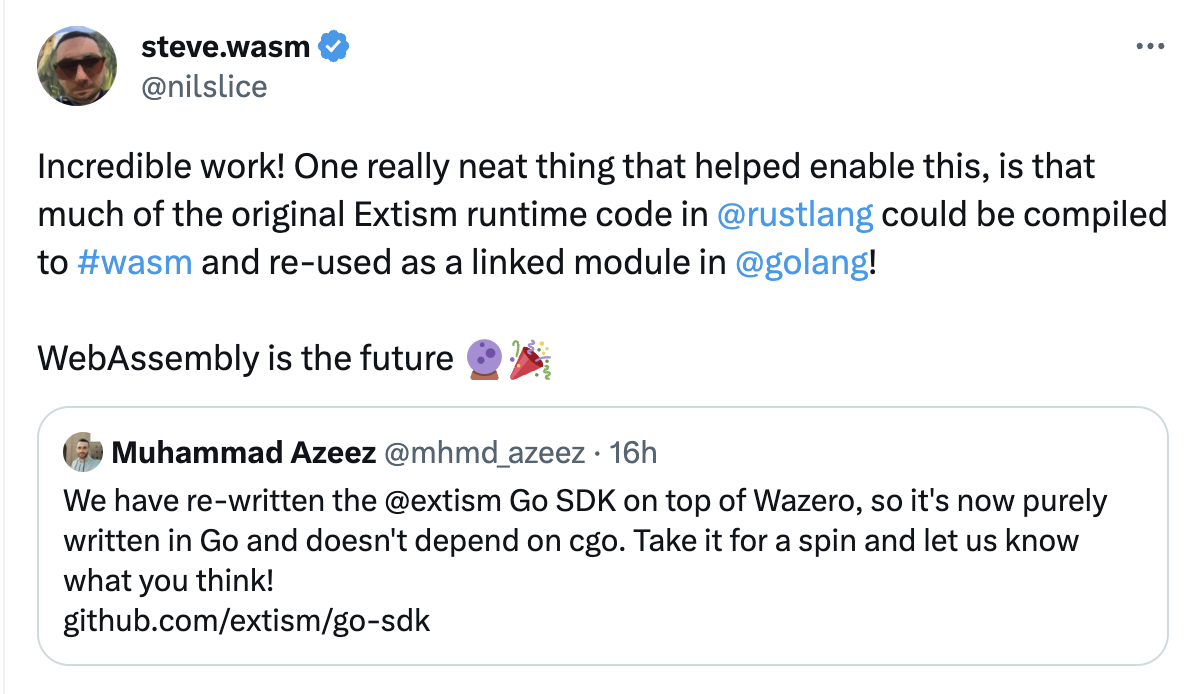Extism Go SDK is now written on top of Wazero
 Philippe Charrière
Philippe CharrièreTable of contents

Since yesterday, the Go SDK of Extism has been officially rewritten with the Wasm Wazero runtime. The new repository is accessible here: https://github.com/extism/go-sdk. And this is excellent news because it means that we can now compile host applications without any C dependencies.

✋ However, the new SDK is not released yet. So, to be able to use it and build your projects, you must:
clone the new repository:
git clonegit@github.com:extism/go-sdk.gitadd a local reference of this git repository into the
go.modfile of your projects:replacegithub.com/extism/extism=> ../go-sdk
Special thanks
A big thank you to Steve Manuel for allowing me to test the new SDK before its release and to Muhammad Azeez for his patience and responsiveness, and to the whole project team for their great work.👏
Build Static application
This means that you can build static and more portable applications (shortcut: once compiled for the target system, you will only need the executable to run and nothing else).
For example, here is how I compile my applications:
export TAG="v0.0.0"
env CGO_ENABLED=0 GOOS=darwin GOARCH=arm64 go build -ldflags="-s -w" -o slingshot-${TAG}-darwin-arm64
env CGO_ENABLED=0 GOOS=darwin GOARCH=amd64 go build -ldflags="-s -w" -o slingshot-${TAG}-darwin-amd64
env CGO_ENABLED=0 GOOS=linux GOARCH=arm64 go build -ldflags="-s -w" -o slingshot-${TAG}-linux-arm64
env CGO_ENABLED=0 GOOS=linux GOARCH=amd64 go build -ldflags="-s -w" -o slingshot-${TAG}-linux-amd64
And for me, my most important use case is that of containerizing my applications. I will be able to create extremely small Docker images thanks to the scratch image. And at a time when web service and FaaS execution platforms often run on Kubernetes, we will gain efficiency and therefore reduce costs:
small executable
small wasm plugin
small container
You can deploy and re-deploy faster with lower memory consumption and disk space.
Create a Docker image
I'm working on a project of an HTTP server to serve Extism Wasm plugins (https://github.com/bots-garden/slingshot/tree/main/slingshot-http-server),
And this is how I create a Docker image of my application:
Create a new Dockerfile:
FROM scratch
ADD slingshot-v0.0.0-linux-arm64 ./
ADD simple.wasm ./
EXPOSE 8080
CMD ["./slingshot-v0.0.0-linux-arm64", "./simple.wasm", "handle", "8080"]
I could have my executable built by docker using the multi-stage technique. But to simplify, I build my executable before and copy it in the image during the construction of this one.
Type the following commands to build the image:
IMAGE_NAME="demo-slingshot"
docker build -t ${IMAGE_NAME} .
docker images | grep ${IMAGE_NAME}
You should get something like this:
demo-slingshot latest 92e0aa64e692 Less than a second ago 8.46MB
My docker image size is less than 9MB!!! 🚀
And I can run my service like this:
IMAGE_NAME="demo-slingshot"
docker run \
-p 8080:8080 \
--rm ${IMAGE_NAME}
Well, this was a short article to explain this excellent news. I have updated the source codes of my series: "Discovery of Extism (The Universal Plug-in System)"
And, now, as I can build very light Docker images, we will see in the next article how to deploy Wasm services on Kubernetes (we'll use the Civo platform).
Have a nice day! 🤗
Subscribe to my newsletter
Read articles from Philippe Charrière directly inside your inbox. Subscribe to the newsletter, and don't miss out.
Written by
